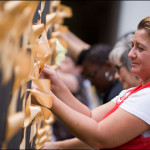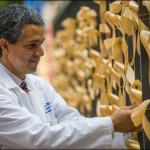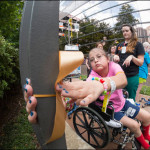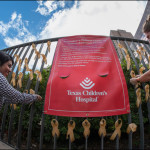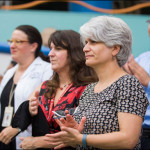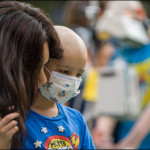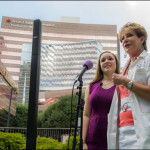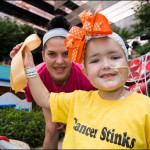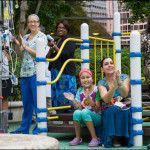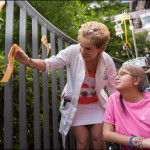October 3, 2014

On October 4, 1989, a bright and ambitious 36-year-old young man walked through the front doors of Texas Children’s Hospital into a building that was just a few stories tall and envisioned something much bigger.
This was Mark A. Wallace’s first day as President and Chief Executive Officer at Texas Children’s Hospital. Wallace had been the senior vice president of The Methodist Hospital before he joined the 1,000 or so physicians, staff and employees at Texas Children’s Hospital. No one suspected this young man would significantly change the history of the hospital for the next two-and-a-half decades.
That one-building hospital that greeted Wallace when he arrived 25 years ago is now an impressively comprehensive campus spread out among several buildings in the Texas Medical Center, a second campus in West Houston, a third campus under construction in The Woodlands, 49 pediatric primary care practices, health centers, the Neurological Research Institute, The Center for Children and Women and Texas Children’s Pavilion for Women. And those 1,000 employees have grown to more than 10,000 in 2014.
“The face of Texas Children’s healthcare has changed tremendously since he’s been here,” said Jackie Ward, assistant vice president of the Cancer Center. “It’s not just bricks and mortar, it’s the programs we’ve implemented for every child, locally, regionally, nationally, and internationally. We have established a portfolio of healthcare access for all of these children and now women.”
Despite the growth, Wallace still walks the hallways like it’s a small hospital, stopping to talk to everyone who comes in his path. His powerful voice is typically heard before he’s seen. He is the embodiment of passion for the mission, making sure to interact with patient families as well as employees.
The early years
When Wallace began his journey with the organization, the hospital was just 35 years old and still in its infancy. Having just separated from St. Luke’s, it was in need of a leader who would help shape its growth and distinguish it amongst other leading children’s hospitals who had the historical advantage of being a century older. His work began immediately.
With Wallace at the helm, Texas Children’s Hospital completed the renovations of the original building, Abercrombie, and began construction of the Clinical Care Center and West Tower. These two additions made Texas Children’s the largest freestanding pediatric hospital in the U.S.
Senior Vice President of Human Resources Linda Aldred joined the organization just one year before Wallace and has seen the tremendous growth under his leadership.
“He doesn’t just come to work every day,” Aldred said. “He comes with the intent to do something profound every day.”
Throughout the 90s the hospital began to strengthen its position as a leader in children’s health care, taking on milestone cases and establishing Texas Children’s Health Plan, the nation’s first pediatric health maintenance organization.
Overcoming challenges
Wallace’s time wasn’t without its difficulties. In 2001, Tropical Storm Allison brought heavy flooding to the region and devastated much of southeast Texas, including Houston, which was hardest hit. The Texas Medical Center saw some of the worst of the storm’s destruction. The dedicated employees at Texas Children’s Hospital were tasked with caring for patients within the hospital and also took on patients from other hospitals that had suffered storm damage.
For Aldred, this difficult time was a shining moment in Wallace’s leadership. After meeting with his leadership team and staff to ensure the situation was under control, Aldred said his next remarks are what stand out to her even now.
“He turned and looked at his leadership team, and, without hesitating, said, ‘Now, let’s take care of the people who were here taking care of our patients. Let’s see what they lost and what we can do for them. And how we help every single one of them,” Aldred said. “Within three days, we had raised more than $200,000. We were a much smaller organization then, but we raised a lot of money, we built a network of caring, we built a network of help.
“People helped people tear their homes down, get rides to work and provided basic life needs for them. I’ll always remember that defining moment when he thought about the hospital, but he never stopped thinking about the people who worked here.”
Positive momentum
The organization’s growth continued with the $1.5 billion Vision 2010 expansion which included the Heal Sick Children campaign which raised $500 million toward supporting the hospital’s priorities. The project involved the expansion of the Feigin Center, the construction of Texas Children’s Pavilion for Women, Texas Children’s Hospital West Campus, and the Jan and Dan Duncan Neurological Research Institute. Vision 2010 marked an unprecedented period of growth for the organization, which would continue its exceptional care of children and would expand its care to women.
“Mark is truly a catalyst leader,” said 2014 Catalyst Leader of the Year Dr. Oluyinka Olutoye, who is also co-director of Texas Children’s Fetal Center. “If you look at the word catalyst, it refers to a person or thing that actually transforms the environment or the reaction that it’s involved in. When you look at the transformative effect Mark Wallace has had on Texas Children’s, there is no question he’s a catalyst here.”
Ward saw Wallace as a mentor and an inspiration to many of his leaders and his entire workforce throughout Vision 2010.
“I saw him through the eyes of my mother, who worked here for 36 years, and now I have the privilege of knowing him as my own leader,” Ward said. “To know him is to love him as your leader because of his passion for what he does and his passion for health care.”
On the horizon
With yet another community hospital set to open in The Woodlands in 2017, the organization continues to see great success in providing the right care at the right place. Wallace’s dedication continues to lead the way for better health care for children and women throughout the global community and has kept Texas Children’s amongst the best places to work according to the Houston Business Journal.
“I look forward to being on his team and watching the evolution continue,” said Dr. Charles Hankins, chief medical officer of West Campus and Texas Children’s Hospital The Woodlands. “Here’s to 25 more years.”









